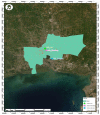Chemical Composition, Sources, and Health Risk Assessment of PM2.5 and PM10 in Urban Sites of Bangkok, Thailand
- PMID: 36361157
- PMCID: PMC9656051
- DOI: 10.3390/ijerph192114281
Chemical Composition, Sources, and Health Risk Assessment of PM2.5 and PM10 in Urban Sites of Bangkok, Thailand
Abstract
Of late, air pollution in Asia has increased, particularly in built-up areas due to rapid industrialization and urbanization. The present study sets out to examine the impact that pollution can have on the health of people living in the inner city of Bangkok, Thailand. Consequently, in 2021, fine particulate matter (PM2.5) and coarse particulate matter (PM10) chemical composition and sources are evaluated at three locations in Bangkok. To identify the possible sources of such particulates, therefore, the principal component analysis (PCA) technique is duly carried out. As determined via PCA, the major sources of air pollution in Bangkok are local emission sources and sea salt. The most significant local sources of PM2.5 and PM10 in Bangkok include primary combustion, such as vehicle emissions, coal combustion, biomass burning, secondary aerosol formation, industrial emissions, and dust sources. Except for the hazard quotient (HQ) of Ni and Mn of PM2.5 for adults, the HQ values of As, Cd, Cr, Mn, and Ni of both PM2.5 and PM10 were below the safe level (HQ = 1) for adults and children. This indicates that exposure to these metals would have non-carcinogenic health effects. Except for the carcinogenic risk (HI) value of Cr of PM2.5 and PM10, which can cause cancer in adults, at Bangna and Din Daeng, the HI values of Cd, Ni, As, and Pb of PM2.5 and PM10 are below the limit set by the U.S. Environmental Protection Agency (U.S. EPA). Ni and Mn pose non-carcinogenic risks, whereas Cr poses carcinogenic risks to adults via inhalation, a serious threat to the residents of Bangkok.
Keywords: air pollution; fine and coarse particles; principal component analysis; risk assessment; source apportionment.
Conflict of interest statement
The authors declare no conflict of interest.
Figures




References
-
- Gurjar B.R., Jain A., Sharma A., Agarwal A., Gupta P., Nagpure A.S., Lelieveld J. Human health risks in megacities due to air pollution. Atmos. Environ. 2010;44:4606–4613. doi: 10.1016/j.atmosenv.2010.08.011. - DOI
-
- Ma Y., Weber R.J., Lee Y.N., Orsini D.A., Maxwell-Meier K., Thornton D.C., Bandy A.R., Clarke A.D., Blake D.R., Sachse G.W., et al. Characteristics and influence of biosmoke on the fine-particle ionic composition measured in Asian outflow during the transport and chemical evolution over the Pacific (TRACE-P) experiment. J. Geophys. Res. 2003;108:8816. doi: 10.1029/2002JD003128. - DOI
-
- Terzi E., Argyropoulos G., Bougatioti A., Mihalopoulos N., Nikolaou K., Samara C. Chemical composition and mass closure of ambient PM10 at urban sites. Atmos. Environ. 2010;44:2231–2239. doi: 10.1016/j.atmosenv.2010.02.019. - DOI
Publication types
MeSH terms
Substances
LinkOut - more resources
Full Text Sources
Research Materials

